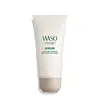What's inside
What's inside
 Key Ingredients
Key Ingredients

 Benefits
Benefits

 Concerns
Concerns

 Ingredients Side-by-side
Ingredients Side-by-side

Water
Skin ConditioningPrunus Mume Fruit Water
HumectantCocamidopropyl Hydroxysultaine
CleansingPhaseolus Radiatus Seed Extract
Skin ConditioningSodium Cocoyl Isethionate
CleansingGlycerin
HumectantSodium Chloride
MaskingCamellia Sinensis Leaf Extract
AntimicrobialHouttuynia Cordata Extract
Skin ConditioningNelumbo Nucifera Flower Extract
Skin ConditioningOryza Sativa Extract
AbsorbentPrunus Mume Fruit Extract
HumectantVaccinium Angustifolium Fruit Extract
Skin ProtectingGuar Hydroxypropyltrimonium Chloride
Skin ConditioningCoconut Acid
CleansingEthylhexylglycerin
Skin ConditioningCaprylyl Glycol
EmollientSodium Isethionate
CleansingCitric Acid
BufferingButylene Glycol
Humectant1,2-Hexanediol
Skin ConditioningHydroxyacetophenone
AntioxidantDextrin
AbsorbentMelia Azadirachta Leaf Extract
Skin ConditioningMelia Azadirachta Flower Extract
Skin ConditioningGardenia Florida Fruit Extract
Skin ConditioningPropylene Glycol Laurate
Skin ConditioningSodium Citrate
BufferingDisodium EDTA
Water, Prunus Mume Fruit Water, Cocamidopropyl Hydroxysultaine, Phaseolus Radiatus Seed Extract, Sodium Cocoyl Isethionate, Glycerin, Sodium Chloride, Camellia Sinensis Leaf Extract, Houttuynia Cordata Extract, Nelumbo Nucifera Flower Extract, Oryza Sativa Extract, Prunus Mume Fruit Extract, Vaccinium Angustifolium Fruit Extract, Guar Hydroxypropyltrimonium Chloride, Coconut Acid, Ethylhexylglycerin, Caprylyl Glycol, Sodium Isethionate, Citric Acid, Butylene Glycol, 1,2-Hexanediol, Hydroxyacetophenone, Dextrin, Melia Azadirachta Leaf Extract, Melia Azadirachta Flower Extract, Gardenia Florida Fruit Extract, Propylene Glycol Laurate, Sodium Citrate, Disodium EDTA
Hydrogenated Polydecene
EmollientCetyl Ethylhexanoate
EmollientSorbitol
HumectantWater
Skin ConditioningGlycerin
HumectantIsododecane
EmollientDimethicone
EmollientDiphenylsiloxy Phenyl Trimethicone
Skin ConditioningSucrose Stearate
EmollientPPG-15-Buteth-20
Skin ConditioningButylene Glycol
HumectantVitis Vinifera Seed Oil
EmollientCarthamus Tinctorius Seed Oil
MaskingPEG-60 Hydrogenated Castor Oil
EmulsifyingSodium Methyl Cocoyl Taurate
CleansingXanthan Gum
EmulsifyingSodium Citrate
BufferingCitric Acid
BufferingPyrus Malus Fruit Water
MaskingSodium Metaphosphate
BufferingTocopherol
AntioxidantCitrus Depressa Peel Extract
HumectantDipropylene Glycol
HumectantAlcohol
AntimicrobialTrisodium EDTA
Phenoxyethanol
PreservativeCI 77492
Cosmetic ColorantBHT
AntioxidantHydrogenated Polydecene, Cetyl Ethylhexanoate, Sorbitol, Water, Glycerin, Isododecane, Dimethicone, Diphenylsiloxy Phenyl Trimethicone, Sucrose Stearate, PPG-15-Buteth-20, Butylene Glycol, Vitis Vinifera Seed Oil, Carthamus Tinctorius Seed Oil, PEG-60 Hydrogenated Castor Oil, Sodium Methyl Cocoyl Taurate, Xanthan Gum, Sodium Citrate, Citric Acid, Pyrus Malus Fruit Water, Sodium Metaphosphate, Tocopherol, Citrus Depressa Peel Extract, Dipropylene Glycol, Alcohol, Trisodium EDTA, Phenoxyethanol, CI 77492, BHT
 Reviews
Reviews

Ingredients Explained
These ingredients are found in both products.
Ingredients higher up in an ingredient list are typically present in a larger amount.
Butylene Glycol (or BG) is used within cosmetic products for a few different reasons:
Overall, Butylene Glycol is a safe and well-rounded ingredient that works well with other ingredients.
Though this ingredient works well with most skin types, some people with sensitive skin may experience a reaction such as allergic rashes, closed comedones, or itchiness.
Learn more about Butylene GlycolCitric Acid is an alpha hydroxy acid (AHA) naturally found in citrus fruits like oranges, lemons, and limes.
Like other AHAs, citric acid can exfoliate skin by breaking down the bonds that hold dead skin cells together. This helps reveal smoother and brighter skin underneath.
However, this exfoliating effect only happens at high concentrations (20%) which can be hard to find in cosmetic products.
Due to this, citric acid is usually included in small amounts as a pH adjuster. This helps keep products slightly more acidic and compatible with skin's natural pH.
In skincare formulas, citric acid can:
While it can provide some skin benefits, research shows lactic acid and glycolic acid are generally more effective and less irritating exfoliants.
Most citric acid used in skincare today is made by fermenting sugars (usually from molasses). This synthetic version is identical to the natural citrus form but easier to stabilize and use in formulations.
Read more about some other popular AHA's here:
Learn more about Citric AcidGlycerin is already naturally found in your skin. It helps moisturize and protect your skin.
A study from 2016 found glycerin to be more effective as a humectant than AHAs and hyaluronic acid.
As a humectant, it helps the skin stay hydrated by pulling moisture to your skin. The low molecular weight of glycerin allows it to pull moisture into the deeper layers of your skin.
Hydrated skin improves your skin barrier; Your skin barrier helps protect against irritants and bacteria.
Glycerin has also been found to have antimicrobial and antiviral properties. Due to these properties, glycerin is often used in wound and burn treatments.
In cosmetics, glycerin is usually derived from plants such as soybean or palm. However, it can also be sourced from animals, such as tallow or animal fat.
This ingredient is organic, colorless, odorless, and non-toxic.
Glycerin is the name for this ingredient in American English. British English uses Glycerol/Glycerine.
Learn more about GlycerinSodium Citrate is the sodium salts of citric acid. In skincare, it is used to alter pH levels and acts as a preservative.
Its main functions are to maintain the pH of a product and neutralize metal ions.
The acidity of our skin is maintained by our glands and skin biome; normal pH level of skin is slightly acidic (~4.75-5.5).
Being slightly acidic allows our skin to create an "acid mantle". This acid mantle is a thin barrier that protects our skin from bacteria and contaminants.
Learn more about Sodium CitrateWater. It's the most common cosmetic ingredient of all. You'll usually see it at the top of ingredient lists, meaning that it makes up the largest part of the product.
So why is it so popular? Water most often acts as a solvent - this means that it helps dissolve other ingredients into the formulation.
You'll also recognize water as that liquid we all need to stay alive. If you see this, drink a glass of water. Stay hydrated!
Learn more about Water